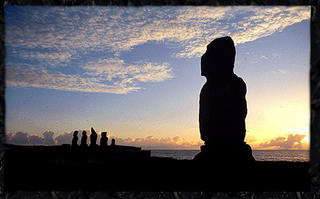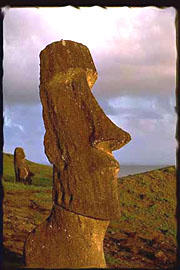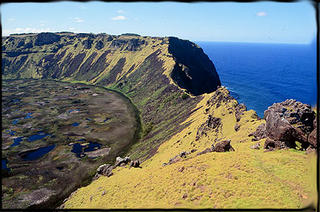The Moai

 with seafarers from a distant culture landed upon its shores. Over the centuries that followed a remarkable society developed in isolation on the island. For reasons still unknown they began carving giant statues out of volcanic rock. These monuments, known as ‘Moai’, are some of the most incredible ancient relics ever discovered.
with seafarers from a distant culture landed upon its shores. Over the centuries that followed a remarkable society developed in isolation on the island. For reasons still unknown they began carving giant statues out of volcanic rock. These monuments, known as ‘Moai’, are some of the most incredible ancient relics ever discovered.Easter Island is a tiny speck of land in the South Pacific located between Chile and Tahiti. Roughly triangular and covering only 64 square miles, it was formed when a plume of hot material rose from deep within the Earth’s interior, burned through the crust and erupted onto the surface as lava. There are 70 eruptive centers on the island but none has known activity since the island was colonized 1300 years ago.
covering only 64 square miles, it was formed when a plume of hot material rose from deep within the Earth’s interior, burned through the crust and erupted onto the surface as lava. There are 70 eruptive centers on the island but none has known activity since the island was colonized 1300 years ago.
It is upon the shores of Anakena, where legends say King Hoto Matua landed in his canoe and began the colonization of the island. The first islanders found a lush land, filled with giant palms which they used for building boats and houses. Almost everyone has seen the iconic images of the Easter Island statues staring silently out from the hill side. It is unclear why the Easter Islanders turned to statue construction on such a massive scale. Their obsession with it ultimately brought about their downfall as they depleted more and more of the forests for use in the process of moving the giant Moai. While the why is a mystery, where it happened and to a large degree how it happened is fairly clear. Each moai was born from the massive caldera of Rano Raraku.The slopes of Rano Raraku are filled with eyeless Moai – several hundred circle the crater in various stages of construction. Centuries of erosion from the slopes have covered all but the tops of these giants – the largest Moai ever constructed. One of the unfinished Moai completely carved but not removed from the crater wall, is a staggering 70 feet in length.
Almost everyone has seen the iconic images of the Easter Island statues staring silently out from the hill side. It is unclear why the Easter Islanders turned to statue construction on such a massive scale. Their obsession with it ultimately brought about their downfall as they depleted more and more of the forests for use in the process of moving the giant Moai. While the why is a mystery, where it happened and to a large degree how it happened is fairly clear. Each moai was born from the massive caldera of Rano Raraku.The slopes of Rano Raraku are filled with eyeless Moai – several hundred circle the crater in various stages of construction. Centuries of erosion from the slopes have covered all but the tops of these giants – the largest Moai ever constructed. One of the unfinished Moai completely carved but not removed from the crater wall, is a staggering 70 feet in length. Ahu Tongariki, on the south coast of Easter Island was the site of one of the largest of the Moai. The large flat plain below Rano Raraku provided easy access to the quarry and as a result the largest of the Moai were erected here. However, in 1960, a massive tidal wave generated by an earthquake off the coast of Chile hit Ahu Tongariki and destroyed the platform and swept the massive Moai hundreds of yards inland.
Ahu Tongariki, on the south coast of Easter Island was the site of one of the largest of the Moai. The large flat plain below Rano Raraku provided easy access to the quarry and as a result the largest of the Moai were erected here. However, in 1960, a massive tidal wave generated by an earthquake off the coast of Chile hit Ahu Tongariki and destroyed the platform and swept the massive Moai hundreds of yards inland.
Built in 1460 Ahu Akivi was one of the later constructions built, probably at a time when the statue cult was beginning to unravel. Unlike other sites, Akivi is inland and has a commanding view of the western part of the island. Its 7 Moai, all about 14 feet tall and approximately 12 metric tons each, are remarkably similar. Rano Kau is not known for its giant Moai or dramatic ruins but for its natural beauty. It is not until you get to the very top of the trail that you see the view. A giant caldera with glistening lakes and marshes dots the floor of the crater. On the other side the knife edge crater wall drops 1000 feet to the deep blue sea. This was the final setting for Rapa Nui culture. It was here on the crater's rim that they built the village of Orongo. Up until the 1878 the islanders practiced ancient rights and tests of skill. Most famous was the ritual whereby Rapa Nui would scale down the sheer cliffs, swim through shark infested water and then fast on the tiny islets off shore waiting for the first sooty tern to lay her eggs. The winner of the competition had special rights and privileges granted them for the duration of the following year.
Rano Kau is not known for its giant Moai or dramatic ruins but for its natural beauty. It is not until you get to the very top of the trail that you see the view. A giant caldera with glistening lakes and marshes dots the floor of the crater. On the other side the knife edge crater wall drops 1000 feet to the deep blue sea. This was the final setting for Rapa Nui culture. It was here on the crater's rim that they built the village of Orongo. Up until the 1878 the islanders practiced ancient rights and tests of skill. Most famous was the ritual whereby Rapa Nui would scale down the sheer cliffs, swim through shark infested water and then fast on the tiny islets off shore waiting for the first sooty tern to lay her eggs. The winner of the competition had special rights and privileges granted them for the duration of the following year. The story of the Easter Island Civilisation is a story of resource exploitation and depletion. The trees were cut for lumber for housing, wood for fires, and eventually for the rollers and lever-like devices used to move and erect the Moai. As the
The story of the Easter Island Civilisation is a story of resource exploitation and depletion. The trees were cut for lumber for housing, wood for fires, and eventually for the rollers and lever-like devices used to move and erect the Moai. As the  deforestation continued the Moai building competition turned into an obsession. The small amount of topsoil quickly washed into the sea. The crops began to fail and the clans turned on one another in a battle for the scarce resources. The symbols of the islanders' power and success, the Moai, were toppled. The violence grew worse and worse. It was said that the victors would eat their dead enemies to gain strength, bones found on the island show evidence of this cannibalism. With the scarce food supplies it may have been a question of hunger as well as being ceremonial. A spooky cave at the southwest corner of the island, Ana Kai Tangata, is translated to "cave where men are eaten." The few survivors of the conflict, perhaps numbering as low as 750, began to pick up the pieces of their culture. One thing they left behind, however, were the Moai...
deforestation continued the Moai building competition turned into an obsession. The small amount of topsoil quickly washed into the sea. The crops began to fail and the clans turned on one another in a battle for the scarce resources. The symbols of the islanders' power and success, the Moai, were toppled. The violence grew worse and worse. It was said that the victors would eat their dead enemies to gain strength, bones found on the island show evidence of this cannibalism. With the scarce food supplies it may have been a question of hunger as well as being ceremonial. A spooky cave at the southwest corner of the island, Ana Kai Tangata, is translated to "cave where men are eaten." The few survivors of the conflict, perhaps numbering as low as 750, began to pick up the pieces of their culture. One thing they left behind, however, were the Moai...



8 Comments:
nice !
where the defination gone ?
I have been inspired!...This is my first attempt at travel journalism! plz plz comment!
what a lot do i not know!!that itself could fill the ancient library of alexandria!
anyways thanks for dropping by and commenting.which year, which honours are you in?would love to get to know thru the blogworld
;-)
What a fascinating story! I mean, I knew about the Moai, but really not much about their history...the canniballism and everything. wow.
Really well written. But you know...I guess a travelogue works best when you have actually been there. This is very well researched and would probably get you an A+ in your geography project...but it's not the real thing. You know, a few anecdotes, excerpts of an interview with a local, folklore, how you lived over there, a little humour...these give it an authenticity. Try writing about a place you've been to. I'm sure it'll be great
just got here blog-hopping...find ita very different blog and quite a good one... u r in comp sc?? where did the material for this post and the last one come out of??
yes...i guess being there in person would really be a different experience and consequently the whole writeup would be different. I havent been to many interesting places but lets see what i can muster! Thnx for the advice!!!
Thnk you mr. Lancelot! yes i'm in honourable comp sc. and the material is partly from the loads of books i have, tv programmes, the internet and hearsay! thnx for dropping by!
the 55 word story willl appear on my next post!
keep it up. you can travel round the world for free if the writing is sane enough, and sadly, commercial enough. your writing is solid. like it. i would read your articles.
Post a Comment
<< Home